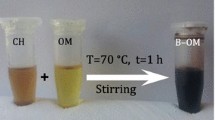Abstract
Nigella sativa (NS) oil is an anti-inflammatory agent in the traditional medicine. In the present study, novel electrospun mats contained NS oil/polyacrylonitrile as a sustained release nano-bandage was studied to treat rheumatoid arthritis. It fabricated by one and two-nozzle electrospinning method. To prepare this material, various amount of NS oil as; 8, 10, 12 and 15 wt% was added to the specific polyacrylonitrile (PAN) concentration as the initial spinnable solution. In addition, Tween80 was used as an emulsifier to improve the NS oil release and limit the burst release. Chemical and mechanical properties of the nanofibers were studied by scanning electron microscopy (SEM), FTIR and tensile test. The in vitro release of NS oil from the nanofibers was determined using UV-Vis spectroscopy. The release profiles of the singular and hybrid nanofibers produced by both one- and two-nozzle electrospinning methods were compared and the results showed a desirable controlled release for hybrid nanofibrous mats in 5 days. The inherent difference of PAN solution and NS oil could make quasi core-shell nanofiber with PAN core and NS oil cortex. Core-shell structure could be responsible for the observed burst release. Tween80 may cause some weak bonds between PAN surface and NS oil molecule that limit the burst release and act as an enhancer agent. The tensile modules for these samples were measured and the sample with 8 wt% NS oil was selected as the optimum case. The cytotoxicity results showed the cell viability to PAN nanofiber was almost about 93%.

preparation of different types of Nigella Sativa electrospun pad.
Similar content being viewed by others
References
Ahmad A, Husain A, Mujeeb M, Khan SA, Najmi AK, Siddique NA, Damanhouri ZA, Anwar F (2013) A review on therapeutic potential of Nigella sativa: a miracle herb. Asian Pac J Trop Biomed 3(5):337–352
Ahmadian H, Veisi H, Karami C, Sedrpoushan A, Nouri M, Jamshidi F, Alavioon I (2015) Cobalt manganese oxide nanoparticles as recyclable catalyst for efficient synthesis of 2-aryl-1-arylmethyl-1H-1, 3-benzimidazoles under solvent-free conditions. Appl Organomet Chem 29(5):266–269
Al-Hadera A, Aqel M, Hasan Z (1993) Hypoglycemic effects of the volatile oil of Nigella sativa seeds. Int J Pharm 2(31):96– 100
Ali Z, Ferreira D, Carvalho P, Avery MA, Khan IA (2008) Nigellidine-4-o-sulfite, the first sulfated indazole-type alkaloid from the seeds of Nigella sativa. J Nat Prod 71(6):1111–1112
Chronakis IS (2005) Novel nanocomposites and nanoceramics based on polymer nanofibers using electrospinning process-A review. J Mater Process Tech 2-3(167):283–293
Dabirian F, Ravandi SAH, Hinestroza JP, Abuzade RA (2012) Conformal coating of yarns and wires with electrospun nanofibers. Polym Eng Sci 52(8):1724–1732
Goyal R, Macri LK, Kaplan HM, Kohn J (2015) Nanoparticles and nanofibers for topical drug delivery J Controlled Release (in press)
Huang ZM, Zhang YZ, Kotaki M, Ramakrishna S (2003) A review on polymer nanofibers by electrospinning and their applications in nanocomposites. Compos Sci Technol 63(15):2223–2253
Huang ZM, Zhang YZ, Ramakrishna S, Lim CT (2004) Electrospinning and mechanical characterization of gelatin nanofibers. Polymer 45(15):5361–5368
Khanna T, Zaidi FA, Dandiya PC (1993) CNS And analgesic studies on Nigella sativa. Fitoterapia 64 (5):407–410
Kenawy ER, Bowlin GL, Mansfield K, Layman J, Simpson DG, Sanders EH, Wnek GE (2002) Release of tetracycline hydrochloride from electrospun poly(ethylene-co-vinylacetate), poly(lactic acid), and a blend. J Control Release 81(1–2):57–64
Khajavi R, Abbasipourb M (2012) Electrospinning as a versatile method for fabricating coreshell, hollow and porous nanofibers. Scientia Iranica 19(6):2029–2034
Lee MW, An S, Lee C, Liou M, Yarin AL, Yoon SS (2014) Self-healing transparent core–shell nanofiber coatings for anti-corrosive protection. J Mater Chem A 2(19):7045–7053
Liu Y, Gu J, Zhang J, Yu F, Wang J, Niea N, Li W (2015) LifePO4 nanoparticles growth with preferential (010) face modulated by Tween-80. RSC Adv 5:9745–9751
Mutabagani A, El-Mahdy SAM (1997) M. A study of the antiinflammatory activity of Nigella sativa L. and thymoquinone in rats. SPJ 5(2):110–113
Mary LA, Senthilram T, Suganya S, Nagarajan L, Venugopal J, Ramakrishna S, Giri Dev VR (2013) Centrifugal spun ultrafine fibrous web as a potential drug delivery vehicle. Express Polym Lett 3(7):238–248
Ogawa H, Saito K (1995) Oxidation behavior of polyacrylonitrile fibers evaluated by new stabilization index. Carbon 6(33):783–788
Oughton PJ, Zarka R, Heras B, Hoult JR (1995) Fixed oil of Nigella sativa and derived thymoquinone inhibit eicosanoid generation in leukocytes and membrane lipid peroxidation. Planta Med 61:33–36
Ramakrishna S, Fujihara K, Teo WE, Lim TC, Ma Z (2005) An introduction to electrospinning and nanofibers. World Scientific Publishing Company, Singapore. ISBN 978-981-256-415-3 and 978-981- 256-454-2
Rohman A, Ariani R (2013) Authentication of Nigella sativa seed oil in binary and ternary mixtures with corn oil and soybean oil using FTIR spectroscopy coupled with partial least square. Sci World J 11:740142
Tembhurne SV, Feroz S, More BH, Sakarkar DM (2014) A review on therapeutic potential of Nigella sativa (kalonji) seeds. J Med Plants Res 8(3):167–177
Worthen DR, Ghosheh OA, Crooks PA (1998) The in vitro anti-tumor activity of some crude and purified components of blackseed, Nigella sativa L. Anticancer Res 18(3):1527–1532
Yousefi M, Karami C (2014) The synthesis of CuO nanoparticles and investigating its effect at different temperature. Adv Environment Biol 8(6):2113–2117
Zaoui A, Cherrah Y, Alaoui K, Mahassine N, Amarouch H, Hassar M (2002) Effects of Nigella sativa fixed oil on blood homeostasis in rat. J Ethnopharmacol 79(1):23–26
Acknowledgments
The authors gratefully acknowledge the Research Council of Kermanshah University of Medical Sciences (Grant Number: 95104) for the financial support.
Author information
Authors and Affiliations
Corresponding authors
Rights and permissions
About this article
Cite this article
Kalhori, F., Arkan, E., Dabirian, F. et al. Controlled Preparation and Characterization of Nigella Sativa Electrospun Pad for Controlled Release. Silicon 11, 593–601 (2019). https://doi.org/10.1007/s12633-018-9931-z
Received:
Accepted:
Published:
Issue Date:
DOI: https://doi.org/10.1007/s12633-018-9931-z




